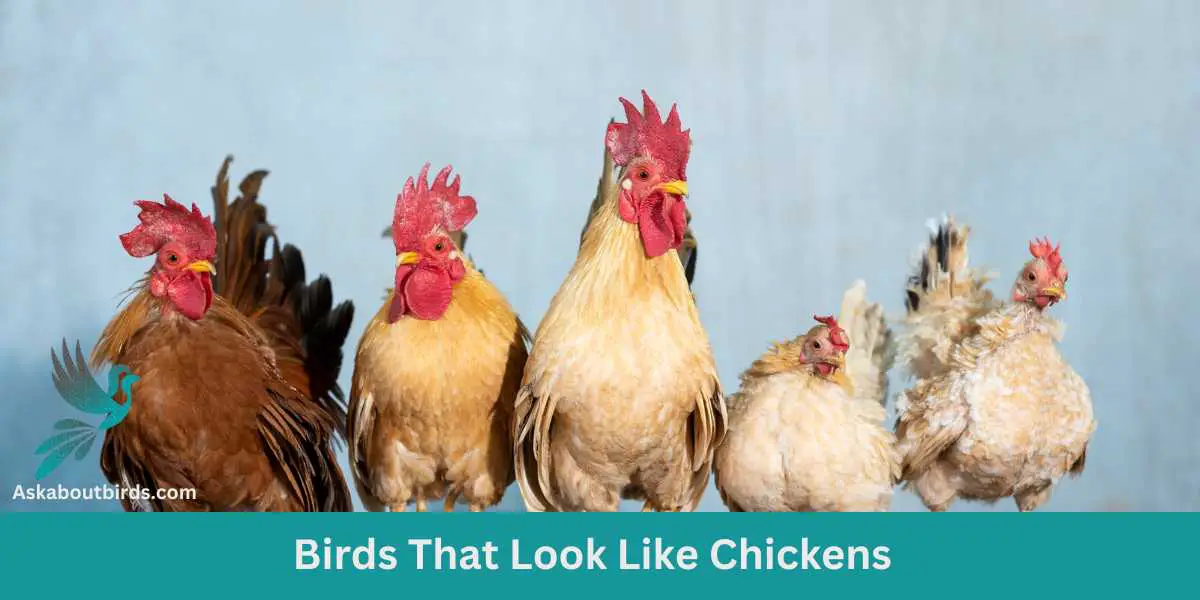Several bird species bear a striking resemblance to chickens, particularly game birds from the family Phasianidae, such as guinea fowls and peafowls. These species share similar size, coloration, and body shape to domestic chickens. They often have a stout body, rounded wings, and short beaks, all of which make them look chicken-like to the untrained eye.
Key Takeaways:
Birds from the family Phasianidae, including guinea fowls and peafowls, are closely akin to chickens in appearance.
These species share similar size, coloration, and body shape with domestic chickens.
Characteristic features like a stout body, rounded wings, and short beaks contribute to their chicken-like appearance.
List of Birds That Look Like Chickens
Pheasants: Blood Pheasant, Blue-Eared Pheasant, Copper Pheasant, Crested Fireback, Crestless Fireback, Edward’s Pheasant, Green Pheasant, Hoogerwerf’s Pheasant, Koklass Pheasant, Mountain Peacock Pheasant, Ring-Necked Pheasant, Siamese Fireback, Swinhoe’s Pheasant, White-Eared Pheasant.
Grouse: Black Grouse, Rock Ptarmigan, Ruffed Grouse.
Quail: Gambel’s Quail.
Other birds: Greater Prairie-Chicken, Northern Bobwhite Quail, Plain Chachalaca, Scaled Quail, Wild Turkey.
Plain Chachalaca
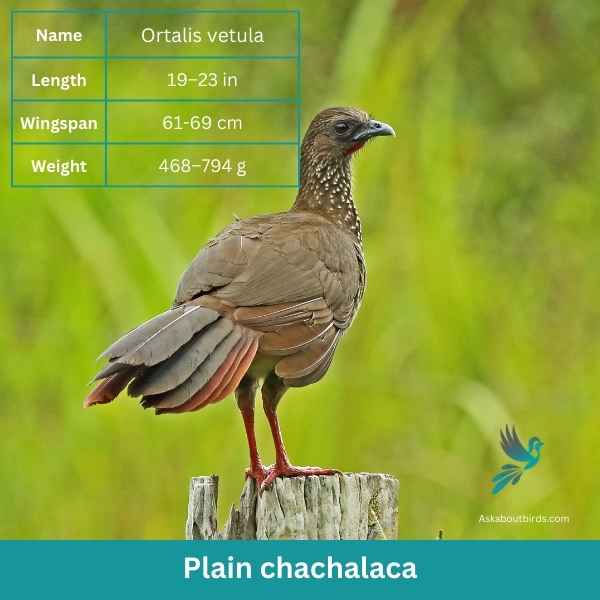
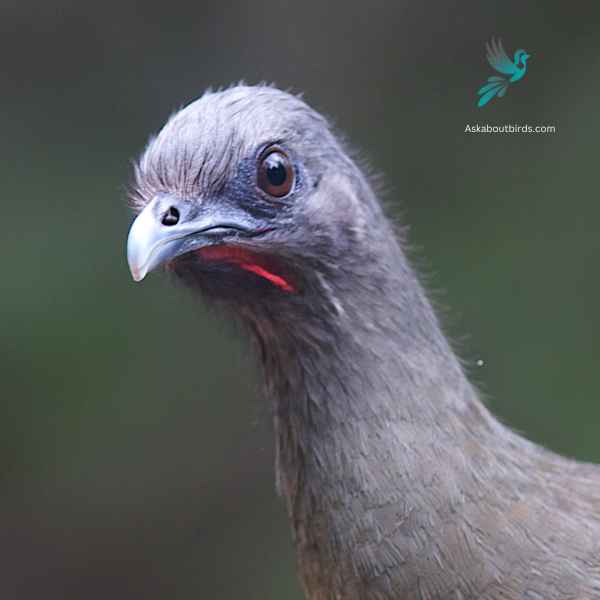
| Feature | Measurement |
|---|---|
| Scientific Name | Ortalis vetula |
| Length | 19–23 in |
| Wingspan | 61-69 cm |
| Weight | 468–794 g |
The Plain Chachalaca (Ortalis vetula) is a large, pheasant-like bird of the Cracidae family, found primarily in the tropical and subtropical regions of the Americas. Distinguished by its long, slim neck and small head, this bird has an overall dull brown plumage that effectively blends into the woodland and scrub habitats it typically resides in. Their name “Chachalaca” comes from the loud, raucous calls that the birds make, especially at dawn and dusk, which sound somewhat like “cha-cha-lac”.
The Plain Chachalaca is largely arboreal, spending most of its time in trees. Its diet primarily consists of plant matter, including fruits, leaves, flowers, and seeds, though it occasionally feeds on small invertebrates. This species is noted for its social behavior, often seen in small groups or families foraging together. Although Plain Chachalacas are not currently threatened and have a relatively widespread distribution, they are impacted by habitat loss due to deforestation and agricultural expansion. Conservation efforts focusing on habitat preservation are crucial to ensure the long-term survival of this species.
Plain Chachalaca vs. Chicken
Similarities
- Body Size and Shape: Both the Plain Chachalaca and the chicken have relatively large, robust bodies ideal for ground foraging.
- Diet: Both birds are omnivores. They eat a varied diet that includes seeds, fruits, and insects.
- Feet: Like chickens, Plain Chachalacas have strong legs with three toes facing forward and one facing backward, suitable for ground movement.
Differences
- Size: Plain Chachalacas are larger, with a body length of 22-24 inches compared to an average chicken’s body length of 20-36 inches. However, their elongated bodies may make them appear larger than they actually are.
- Color: Plain Chachalacas have olive-brown feathers, which is quite distinct from the varied colors (white, black, brown, multi-colored) found in chickens.
- Tail: The Plain Chachalaca has a long, broad tail, unlike the chicken’s shorter, more rounded tail.
Wild Turkey
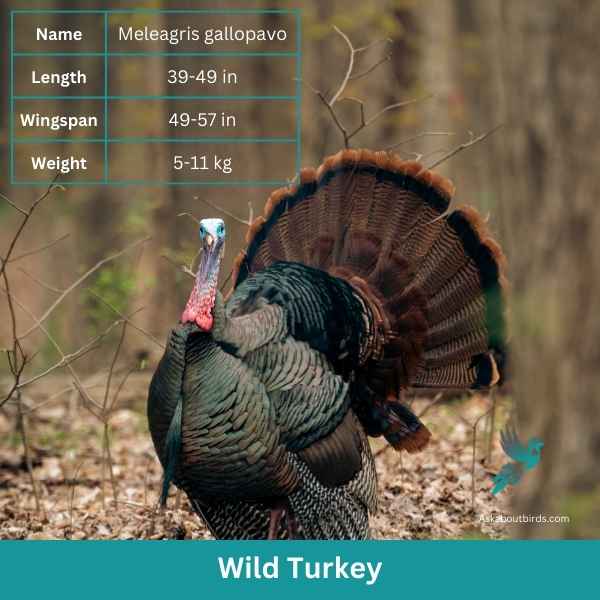
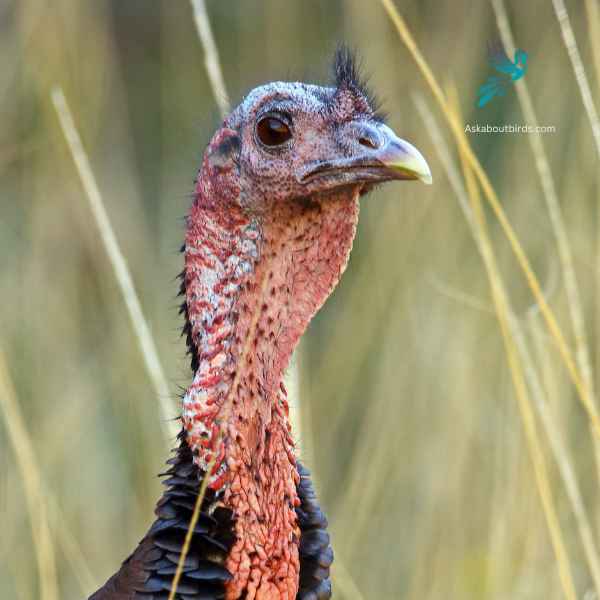
| Feature | Measurement |
|---|---|
| Scientific Name | Meleagris gallopavo |
| Length | 39-49 in |
| Wingspan | 49-57 in |
| Weight | 5-11 kg |
The Wild Turkey (Meleagris gallopavo) is a large, ground-dwelling bird native to North America and is the same species as the domestic turkey, a traditional part of Thanksgiving meals in the United States. Male Wild Turkeys, or toms, are renowned for their large size, reaching up to 4 feet in length and weighing up to 24 pounds. They showcase an iridescent plumage of copper and green, a distinct fan-shaped tail, and a “beard” — a tuft of coarse feathers protruding from the chest. Females, known as hens, are smaller and less colorful, with a predominantly brown or gray plumage.
Wild Turkeys inhabit diverse environments across North America, from hardwood forests to grasslands, taking to the trees at night for protection from predators. These omnivorous birds have a varied diet, consuming acorns, seeds, small insects, and even small reptiles and amphibians. Wild Turkeys were on the brink of extinction in the early 20th century due to excessive hunting and habitat destruction. However, through concerted conservation efforts, including reintroduction programs and careful management, their populations have rebounded impressively, marking a significant conservation success story.
Wild Turkey vs. Chicken
Similarities
- Diet: Both Wild Turkeys and chickens are omnivores, consuming a mix of seeds, insects, and fruits.
- Feet: Both birds have strong legs with three toes facing forward and one backward, useful for their ground foraging.
- Social Behavior: Both species are social, often found in groups, though the structure and size of these groups may vary.
Differences
- Size: Wild Turkeys are much larger than most chickens, with a body length of about 36-44 inches compared to an average chicken’s 20-36 inches.
- Color: Wild Turkeys have dark feathers with an iridescent sheen that can display colors like copper, green, and gold in the right light. Chickens, however, come in a variety of colors, including white, black, brown, and multicolored.
- Tail: Wild Turkeys have a large, fan-shaped tail that males (Toms) use during courting displays, unlike the chicken’s smaller and less dramatic tail.
Scaled Quail
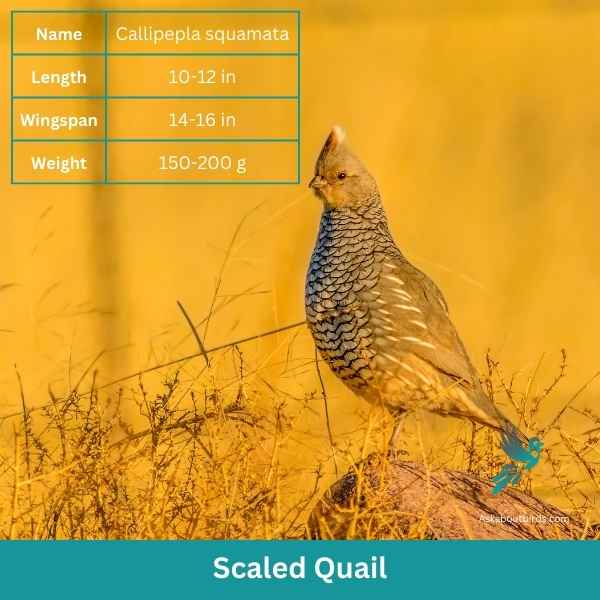
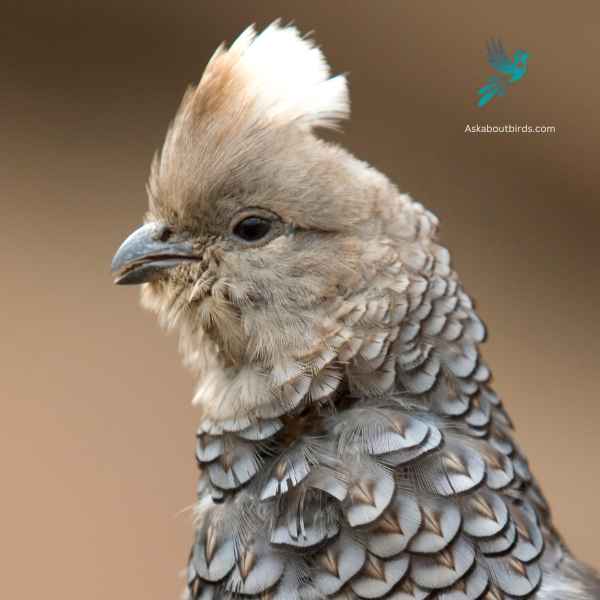
| Feature | Measurement |
|---|---|
| Scientific Name | Callipepla squamata |
| Length | 10-12 in |
| Wingspan | 14-16 in |
| Weight | 150-200 g |
The Scaled Quail (Callipepla squamata), also commonly known as the “Blue Quail” or “Cotton-top” due to its distinctive crest, is a species of the New World quail family. This bird is easily recognized by its blue-gray plumage marked with scaly patterns, giving the species its name. It has a chunky body, a rounded head with a forward-facing crest that looks a bit like a tuft of cotton, and a short tail. While both males and females share similar physical characteristics, males are slightly larger in size.
Scaled Quails inhabit the arid regions of the southwestern United States and Mexico, preferring semi-desert areas with sparse vegetation where they can easily forage for their diet of seeds, leaves, and occasionally insects. They are known for their tendency to run rather than fly when threatened. Though Scaled Quails are currently classified as least concern by the IUCN, they face threats from habitat loss due to agriculture and overgrazing. This makes efforts to conserve their habitat and manage hunting practices important for the continued survival of the species.
Scaled Quail vs. Chicken
Similarities
- Diet: Both Scaled Quail and chickens are omnivores, consuming a variety of seeds, insects, and small fruits.
- Feet: Similar to chickens, Scaled Quails have three forward-facing toes and one backward-facing toe, which are great for their ground-oriented lifestyle.
- Social Behavior: Both bird species tend to be social, often found in groups or pairs.
Differences
- Size: Scaled Quails are much smaller than most chickens, with a body length of about 10-12 inches compared to an average chicken’s body length of 20-36 inches.
- Color: Scaled Quails have blue-gray plumage with a pattern that resembles scales (hence their name), which is quite different from the various colors of chickens, which can be white, black, brown, or multicolored.
- Crest: Scaled Quails have a distinctive forward-curving crest or plume, known as a “topknot,” on their heads, unlike chickens which may have a comb but no topknot.
Northern Bobwhite

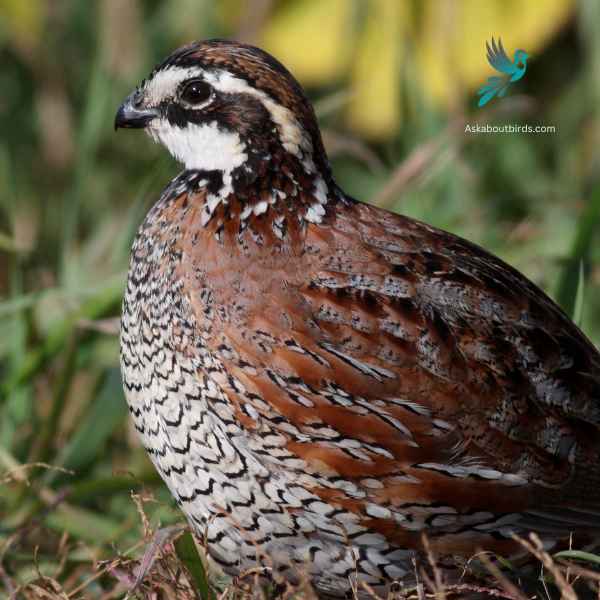
| Feature | Measurement |
|---|---|
| Scientific Name | Colinus virginianus |
| Length | 9.4-11 in |
| Wingspan | 13-15 in |
| Weight | 129-215 g |
The Northern Bobwhite (Colinus virginianus), also simply known as the Bobwhite Quail, is a small, robust bird that is a member of the New World quail family. Named after its distinctive “bob-white” call, this bird is characterized by a round body, short tail, and a small head with a white throat and eye stripe, which is more pronounced in males. The male has a white throat and eye stripe bordered by black, with a reddish-brown coat, while the female’s coloration is more muted, with a buff throat and eye stripe.
Native to the United States, Mexico, and the Caribbean, the Northern Bobwhite inhabits a variety of habitats including grasslands, open woodlands, and field edges. They are a ground-dwelling species, known for their unique social system of forming “coveys” – small, tight-knit groups. They primarily feed on seeds, leaves, and insects. Unfortunately, due to changes in agricultural practices and loss of suitable habitat, the Northern Bobwhite has experienced significant population declines over the past few decades. These declines underscore the importance of targeted conservation efforts to preserve and restore the habitats of this iconic species.
Northern Bobwhite vs. Chicken
Similarities
- Diet: Both Northern Bobwhite and chickens are omnivorous, consuming seeds, insects, and small fruits.
- Feet: Like chickens, Northern Bobwhites have strong legs with three toes facing forward and one facing backward, allowing them to walk and forage effectively on the ground.
- Social Behavior: Both birds are sociable, usually seen in groups or pairs.
Differences
- Size: Northern Bobwhites are much smaller than chickens, with a body length of about 8-11 inches compared to an average chicken’s body length of 20-36 inches.
- Color: Northern Bobwhites have a mixture of brown, white, and gray in their plumage, which differs from the variety of colors (white, black, brown, multicolored) found in chickens.
- Crest: Northern Bobwhites lack a crest or comb on their head, unlike chickens that often have a comb atop their heads.
Ruffed Grouse

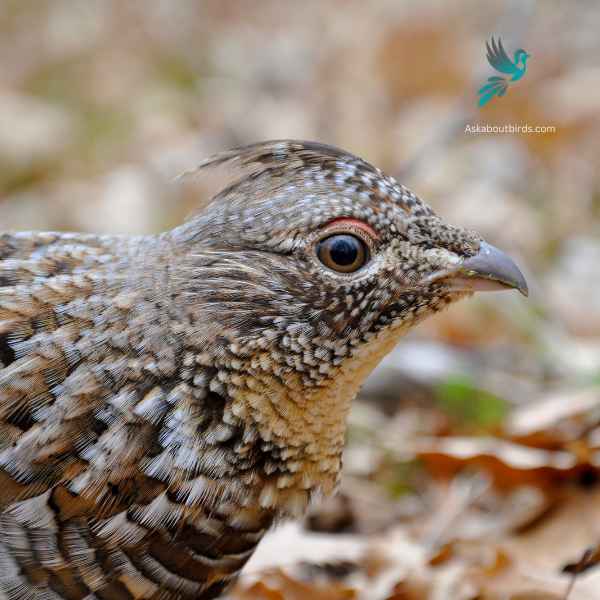
| Feature | Measurement |
|---|---|
| Scientific Name | Bonasa umbellus |
| Length | 16 to 20 in |
| Wingspan | 20–25 in |
| Weight | 450–750 g |
The Ruffed Grouse (Bonasa umbellus) is a medium-sized bird of the grouse family, native to the forests of North America. Its name comes from the unique, large neck ruffs that males display during their remarkable courtship rituals. The bird is characterized by a slightly crested head, a fan-shaped tail banded with a dark stripe near the end, and feathered legs. The color of the Ruffed Grouse can vary significantly, with plumage ranging from a grayish hue to a more reddish-brown, blending effectively with different types of forest habitats.
Inhabiting both deciduous and coniferous forests, the Ruffed Grouse is adapted to a life well off the ground. It primarily feeds on the buds, leaves, and berries of various tree species, but it also consumes insects, especially in the summer months. The Ruffed Grouse is notable for its “drumming” display, where a male beats its wings rapidly to create a low-frequency sound that resonates through the forest, attracting females. While the Ruffed Grouse is currently of least concern from a conservation perspective, habitat loss and changes in forest management practices can impact local populations. It is important that these birds’ habitat needs are taken into consideration in forestry practices to ensure their continued survival.
Ruffed Grouse vs. Chicken
Similarities
- Diet: Both Ruffed Grouse and chickens are omnivores, feeding on a mix of seeds, insects, and fruits.
- Feet: Like chickens, Ruffed Grouse have strong legs with three toes facing forward and one backward, which supports their ground foraging.
- Body Shape: Both birds have a stout, rounded body shape, which aids in their ground-oriented lifestyle.
Differences
- Size: Ruffed Grouse are generally smaller than chickens, with a body length of about 16-19 inches compared to an average chicken’s body length of 20-36 inches.
- Color: Ruffed Grouse have a blend of brown, gray, and black in their plumage, with a notable black band at the tip of their tail – this differs from the range of colors found in chickens.
- Behavior: Unlike chickens, Ruffed Grouse are solitary outside of the breeding season and are well-adapted to cold weather. They can burrow in the snow for warmth and are excellent in flight through dense forests.
Rock Ptarmigan
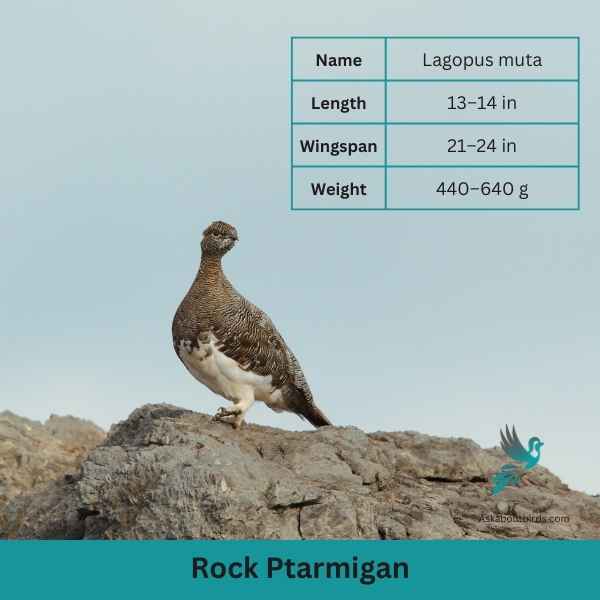
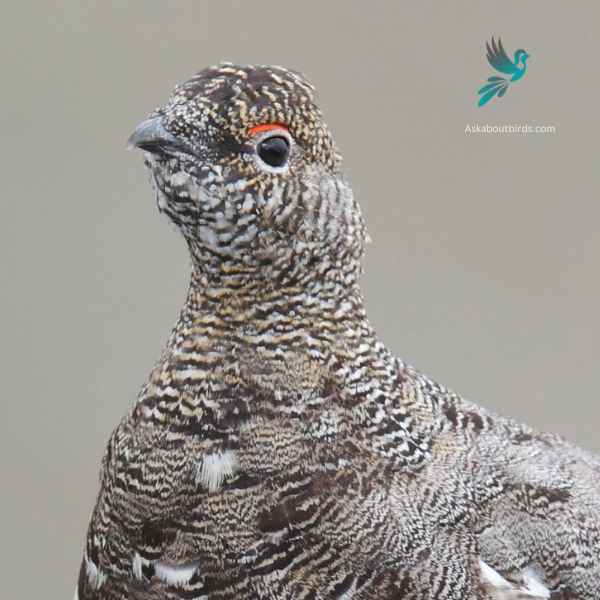
| Feature | Measurement |
|---|---|
| Scientific Name | Lagopus muta |
| Length | 13–14 in |
| Wingspan | 21–24 in |
| Weight | 440–640 g |
The Rock Ptarmigan (Lagopus muta) is a medium-sized game bird in the grouse family. It is renowned for its remarkable ability to change color with the seasons, providing excellent camouflage against predators. In the summer, the Rock Ptarmigan’s plumage is a mixture of grey, brown, and black, blending well with the rocky terrain of its habitat. Come winter, it transforms to pure white, allowing it to hide effectively in snowy landscapes. The only parts of the bird that do not turn white are its eyes, beak, and tail, which remain black year-round.
Endemic to the cold, arctic and subarctic regions of the northern hemisphere, the Rock Ptarmigan is a true tundra specialist. It primarily feeds on buds, leaves, seeds, and berries, but will also consume insects when available during the summer. Despite the harsh conditions in which it lives, the Rock Ptarmigan is a resilient species with a wide distribution. Nonetheless, as a cold-adapted species, it may face challenges with the changing climate and associated habitat shifts. Continued monitoring and appropriate conservation measures will be essential to ensure the future of this remarkable bird.
Rock Ptarmigan vs. Chicken
Similarities
- Diet: Both the Rock Ptarmigan and chickens are omnivores, with a diet including seeds, insects, and berries.
- Feet: Like chickens, Rock Ptarmigans have strong legs with three toes facing forward and one backward, useful for their ground-oriented lifestyle.
- Body Shape: Both species have a stout, rounded body shape that aids in heat conservation during cold weather.
Differences
- Size: Rock Ptarmigans are generally smaller than chickens, with a body length of about 13-15 inches compared to an average chicken’s body length of 20-36 inches.
- Color: Rock Ptarmigans undergo a drastic change in plumage color depending on the season. In winter, they are almost entirely white to blend in with the snow, while in summer, they have brown and black plumage, quite different from the array of colors seen in chickens.
- Habitat: While chickens are typically domesticated and found on farms, Rock Ptarmigans are found in the arctic tundra, alpine regions, and even on rocky mountainsides.
Blue-Eared Pheasant
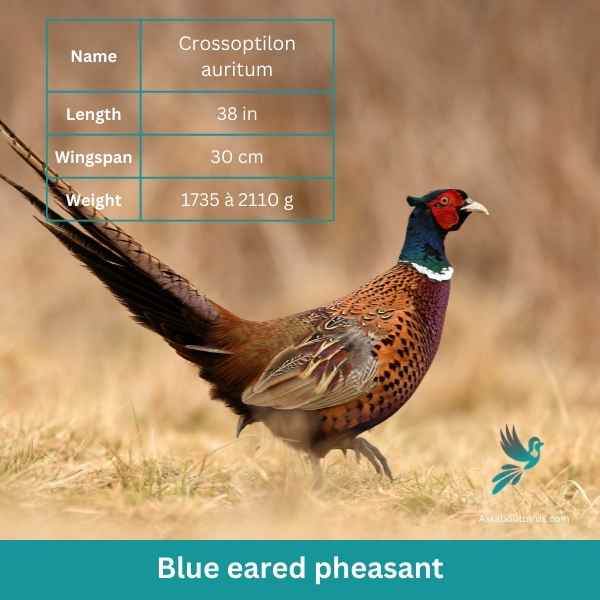
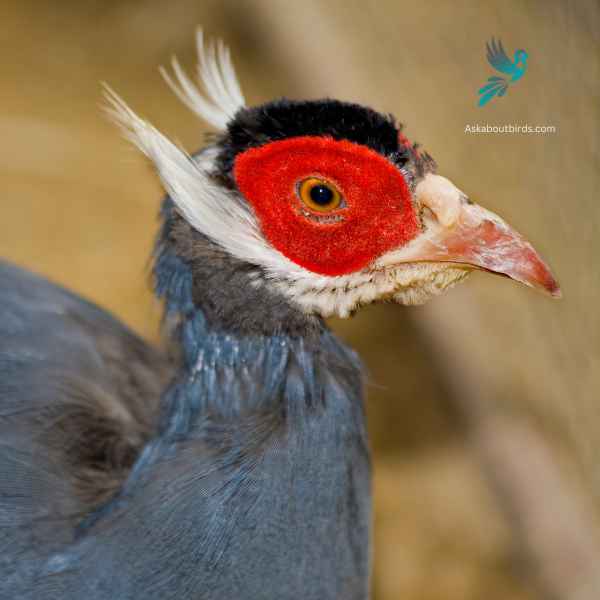
| Feature | Measurement |
|---|---|
| Scientific Name | Crossoptilon auritum |
| Length | 38 in |
| Wingspan | 30 cm |
| Weight | 1735 à 2110 g |
The Blue-Eared Pheasant (Crossoptilon auritum) is a large, strikingly beautiful bird species belonging to the Phasianidae family, which includes other pheasants, partridges, and turkeys. Endemic to China, it is aptly named for the vivid blue feathers that form an eye-catching patch around its ears, contrasting sharply with its primarily black body. With its signature feather crown, distinctive white eyeliner-like streaks, and long tail feathers, the Blue-Eared Pheasant is a magnificent spectacle in the wild.
Despite its beauty, the Blue-Eared Pheasant is known to lead a modest, terrestrial lifestyle in the high mountain regions, typically between 2,000 and 5,000 meters in altitude. This species is characterized by its omnivorous diet, feasting on a diverse range of foods including berries, seeds, roots, and insects. While it remains widespread and relatively common within its range, habitat loss and hunting pose significant threats to its population. Efforts are underway to ensure its conservation and protect this stunning member of the pheasant family.
Blue-Eared Pheasant vs. Chicken
Similarities
- Diet: Both the Blue-Eared Pheasant and chickens are omnivores, consuming a diet including seeds, insects, and berries.
- Feet: Like chickens, Blue-Eared Pheasants have strong legs with three toes facing forward and one backward, ideal for their ground foraging habits.
- Body Shape: Both birds have a robust, rounded body shape, which aids in their ground-dwelling lifestyle.
Differences
- Size: Blue-Eared Pheasants are larger than many chickens, with a body length of about 31-35 inches compared to an average chicken’s body length of 20-36 inches.
- Color: As their name implies, Blue-Eared Pheasants have predominantly dark blue-gray plumage, a feature not seen in chickens which come in a variety of colors including white, black, brown, and multicolored.
- Crest: Blue-Eared Pheasants have a distinctive feathered crest that extends from the top of their head, while chickens typically have a fleshy comb.
Copper Pheasant
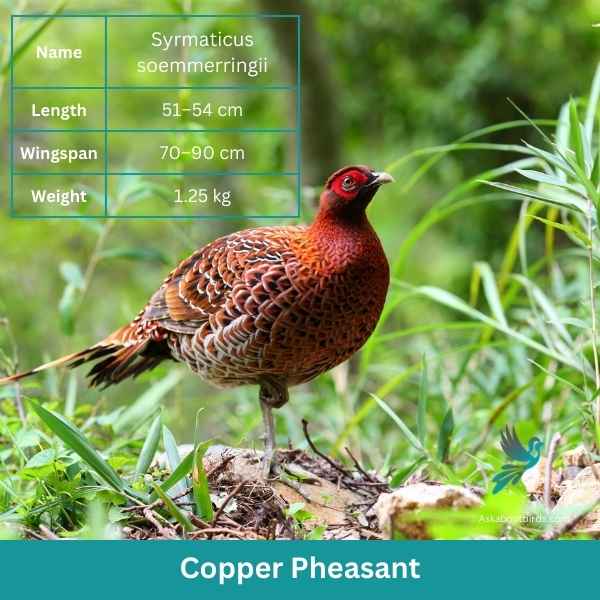

| Feature | Measurement |
|---|---|
| Scientific Name | Syrmaticus soemmerringii |
| Length | 51–54 cm |
| Wingspan | 70–90 cm |
| Weight | 1.25 kg |
The Copper Pheasant, or Syrmaticus soemmerringii, is a strikingly beautiful bird species belonging to the family Phasianidae, and is native to Japan. Renowned for its rich coppery sheen that gives the species its name, the male exhibits a long, brownish tail adorned with thin black bars, a black face, throat, and breast, contrasted by a white belly. The female, on the other hand, is more subtly colored, with a uniform brown plumage interspersed with blackish markings, making for an effective camouflage. The sexual dimorphism in this species is striking, with the males’ splendidly hued plumage standing out starkly against the females’ more understated tones.
In terms of habitat, Copper Pheasants are typically found in dense, deciduous or mixed forests and woodland areas. Their diet predominantly consists of seeds, roots, berries, and small invertebrates, which they forage for on the forest floor. One distinctive aspect of their behavior is their secretive nature, often staying well-hidden in underbrush. While the Copper Pheasant’s population seems stable, ongoing habitat loss and degradation due to human activities pose threats to their existence. Conservation measures are vital to maintain the species and protect their natural habitats.
Copper Pheasant vs. Chicken
Similarities
- Diet: Both the Copper Pheasant and chickens are omnivores, consuming a diet that includes seeds, insects, and berries.
- Feet: Like chickens, Copper Pheasants have strong legs with three toes facing forward and one backward, perfect for their ground foraging behavior.
- Body Shape: Both species have a robust, rounded body shape, suiting their mostly ground-dwelling lifestyle.
Differences
- Size: Copper Pheasants are larger than many chickens, with a body length of about 31-33 inches compared to an average chicken’s body length of 20-36 inches.
- Color: Copper Pheasants, especially males, have a distinctive coppery chestnut plumage, quite different from the variety of colors found in chickens.
- Tail: Copper Pheasants have a long, pointed tail, which is markedly different from the shorter and more rounded tail of a chicken.
Crested Fireback

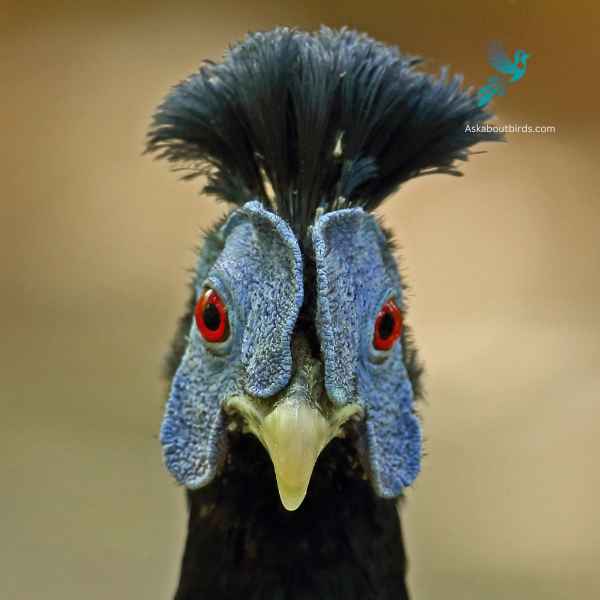
| Feature | Measurement |
|---|---|
| Scientific Name | Lophura ignita |
| Length | 55-70 cm |
| Wingspan | 23.6-27.5 in |
| Weight | 1.2-1.8 kg |
The Crested Fireback (Lophura ignita) is a visually striking bird species belonging to the pheasant family, Phasianidae, and is found predominantly in the forests of Southeast Asia. Males are particularly ornate with a dark, glossy blue-black plumage, a black crest, blue facial skin, and a distinct collar of white feathers. Their back and tail feathers are characterized by a gorgeous pattern of gold and bronze, reminiscent of a blazing fire, hence the name “Fireback”. Females are significantly more muted in color, bearing a predominantly brown plumage with darker spots, serving as an effective camouflage mechanism.
The Crested Fireback inhabits lowland forests, swampy areas, and forested hill regions, where it forages on the forest floor for a diet that includes seeds, berries, invertebrates, and occasionally small reptiles and amphibians. They are primarily terrestrial but are capable of flying short distances to evade predators. Despite their beauty, the Crested Fireback is under threat primarily due to habitat loss and degradation from deforestation and other human activities. As such, conservation efforts are crucial to protect and maintain this remarkable species.
Crested Fireback vs. Chicken
Similarities
- Diet: Both Crested Firebacks and chickens are omnivores, feeding on a mixture of seeds, insects, and small fruits.
- Feet: Like chickens, Crested Firebacks have strong legs with three toes facing forward and one facing backward, useful for their ground-oriented habits.
- Body Shape: Both bird species exhibit a stout, rounded body shape, which helps them in their predominantly ground-dwelling lifestyles.
Differences
- Size: Crested Firebacks are generally larger than chickens, with a body length of about 28-33 inches compared to an average chicken’s body length of 20-36 inches.
- Color: Crested Firebacks exhibit vibrant colors, with males having a blue-black body, a bright chestnut belly, and a yellow or white crest, contrasting the array of colors found in chickens.
- Crest: Unlike most chickens, Crested Firebacks have a distinctive, forward-curving crest atop their heads.
Crestless Fireback
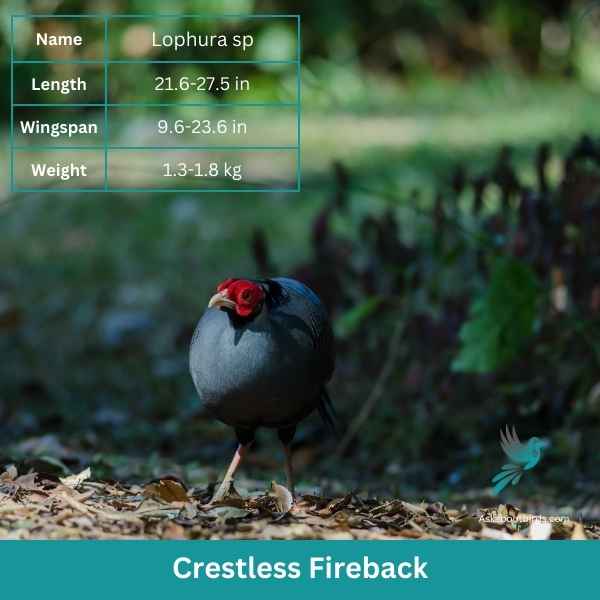
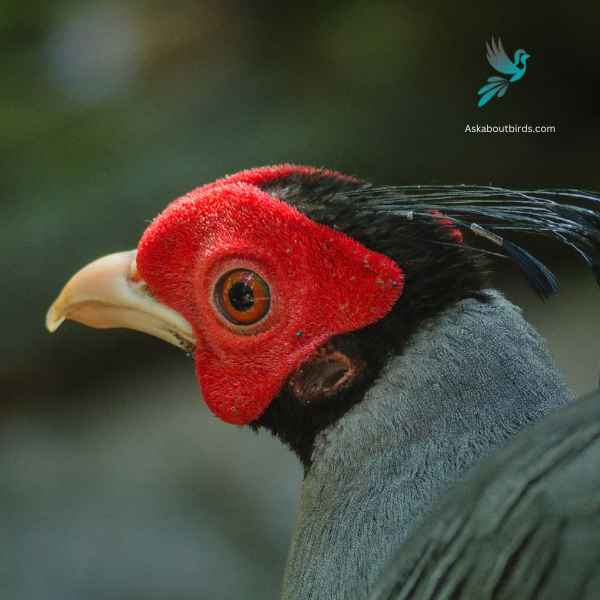
| Feature | Measurement |
|---|---|
| Scientific Name | Lophura ignita |
| Length | 55-70 cm |
| Wingspan | 23.6-27.5 in |
| Weight | 1.2-1.8 kg |
The term “Crestless Pheasant” generally refers to any species of pheasant that does not possess a noticeable crest or tuft of elongated feathers on the head, which is a common feature in many other pheasant species. This lack of a crest can sometimes make identification of these pheasants a little more challenging. However, their unique plumage, color patterns, and other physical characteristics often help in distinguishing these birds. Examples of such species might include the Copper Pheasant (Syrmaticus soemmerringii) and Reeves’s Pheasant (Syrmaticus reevesii), among others.
It’s important to note that the life habits and habitats of crestless pheasants can significantly vary, as they belong to different species spread across various geographical regions. From the temperate forests of Japan, where the Copper Pheasant can be found, to the mixed woodlands of China, the home of Reeves’s Pheasant, these birds display a wide array of behaviors and adaptations to their respective environments. Most of them are omnivorous, consuming a diet of seeds, plant material, insects, and small creatures. While each species faces its own set of conservation challenges, habitat loss is a universal threat, making protective measures vital for their survival.
Crestless Fireback vs. Chicken
Similarities
- Diet: Both the Crestless Fireback and chickens are omnivores, with a diet including seeds, insects, and fruits.
- Feet: Like chickens, Crestless Firebacks have strong legs with three toes facing forward and one backward, ideal for their ground-oriented lifestyle.
- Body Shape: Both birds have a stout, rounded body shape, well-suited for a ground-dwelling lifestyle.
Differences
- Size: Crestless Firebacks are generally larger than chickens, with a body length of about 25-29 inches compared to an average chicken’s body length of 20-36 inches.
- Color: Crestless Firebacks, especially males, have distinctive black and brown plumage with metallic green and purple sheen on their upperparts, which is quite different from the variety of colors found in chickens.
- Crest: Unlike chickens and contrary to their Crested Fireback relatives, Crestless Firebacks do not have a crest on their heads.
Helmeted Guinea Fowl

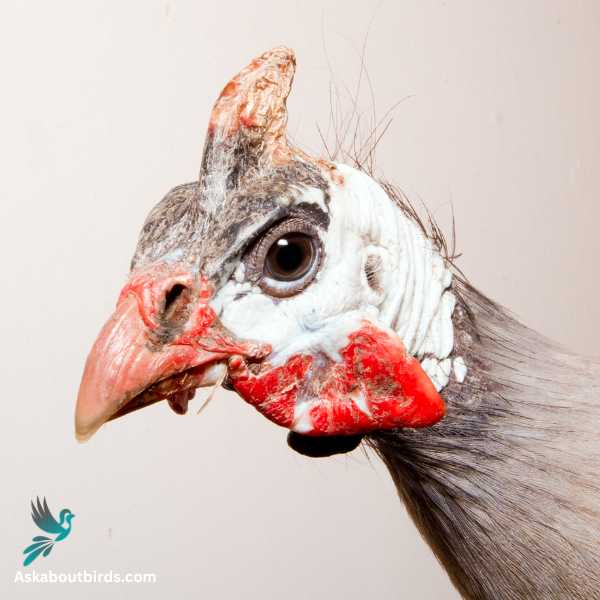
| Feature | Measurement |
|---|---|
| Scientific Name | Numida meleagris |
| Length | 20-24 inches |
| Wingspan | 31-35 inches |
| Weight | 3-4lbs |
The Helmeted Guinea Fowl is renowned for its unique aesthetic features, including a bald, blue head with red wattles and a helmet-like bony casque, complemented by a gray feathered body with white spots. This sociable bird is famous for its loud, distinctive calls used for communication and alerting the flock of potential danger. The species exhibits high adaptability, with a range spanning continents like Africa, Europe, and North America, primarily inhabiting open grasslands, savannahs, and woodland areas. Their habitats provide ideal environments for foraging and nesting.
These birds showcase omnivorous and opportunistic feeding behavior, consuming a wide range of diet, including seeds, fruits, plant matter, insects, and small reptiles. This dietary preference renders them effective pest controllers in farming areas. Helmeted Guinea Fowls engage in a characteristic dust bathing practice during foraging, helping to maintain their plumage. Their breeding habits involve male courtship displays and the creation of ground nests by the females. Post-hatching, the precocial young, known as keets, are quickly mobile and self-feeding. They are, however, protected and guided by their parents until they are capable of integrating into the flock independently.
Helmeted Guinea Fowl vs. Chicken
Similarities
- Size and Body Shape: Like chickens, Helmeted Guinea Fowl have a stout, rounded body shape. Adult guinea fowl are similar in size to many chickens, measuring approximately 20-22 inches long.
- Diet: Both Helmeted Guinea Fowl and chickens are omnivores, consuming a variety of seeds, insects, and small fruits.
- Feet: Like chickens, Helmeted Guinea Fowl have strong legs with three toes facing forward and one facing backward, well-suited for a ground-dwelling lifestyle.
Differences
- Color and Patterns: While chickens can come in a variety of colors, Helmeted Guinea Fowl usually have gray or black plumage with white spots. This distinctive “polka dot” appearance is quite different from the solid or variably patterned feathers of most chickens.
- Head and Neck: Helmeted Guinea Fowl are known for their bare neck and head, adorned with a unique helmet-like casque, wattles, and a beard, features which are not present in chickens.
- Noise: The call of a Helmeted Guinea Fowl is a loud, harsh, and repetitive “kek-kek-kek,” which is quite different from the “cluck” or “crow” of a chicken.
FAQS on chicken like birds (birds that look like chickens)
What birds are similar to domesticated chickens in appearance?
Several bird species bear striking resemblance to domesticated chickens, thanks to their similar body shapes and patterns. California quail, a small ground dwelling bird, has mottled brown and light brown bellies. Blood pheasants, though less commonly found, also resemble chickens with their somewhat similar form and often dark brown plumage. These beautiful birds can be easily mistaken for chickens, especially by those not well-versed in ornithology.
How do green pheasants compare to domesticated chickens?
Green pheasants, like domesticated chickens, are popularly kept in captive breeding programs due to their beautiful, colorful plumage. Originating from Japan, these birds are not only birds that bear resemblance to chickens, but they also share similarities in behavior. They’re more exotic in appearance, featuring greenish feathers rather than the usual brown shades found in chickens.
What are some distinguishing features of black grouse?
The black grouse, scientific name Lyrurus tetrix, is a larger bird species, not typically confused with chickens but it does share some characteristics. Its plumage is mostly dark, with males showcasing a shimmering dark brown almost black coloration. These are game birds known for their impressive courtship displays and are frequently found in oak woodlands.
Are there any chicken-like birds native to the United States?
The California quail, native to the West Coast of the United States, is a small ground dwelling bird that could be mistaken for a chicken. This bird has a distinct topknot, not unlike some chicken breeds, and it has mottled brown feathers with light brown bellies. These birds often inhabit oak woodlands and are known for their distinctive call.

